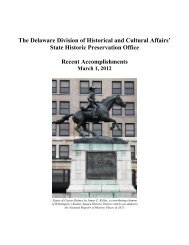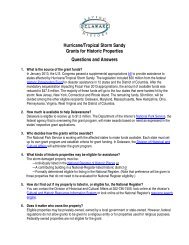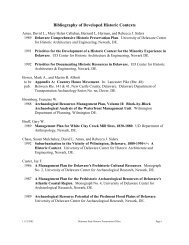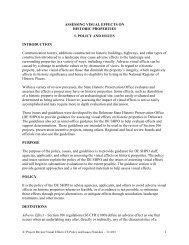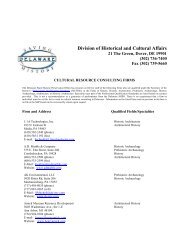Report of the Archaeological Investigations of the New Castle Court ...
Report of the Archaeological Investigations of the New Castle Court ...
Report of the Archaeological Investigations of the New Castle Court ...
Create successful ePaper yourself
Turn your PDF publications into a flip-book with our unique Google optimized e-Paper software.
NEW CASTLE COURT HOUSE PLAZA<br />
NEW CASTLE, DELAWARE<br />
2.0 FIELD INVESTIGATIONS<br />
and/or <strong>the</strong> site formation processes associated with <strong>the</strong>ir deposition. Background and field data<br />
were evaluated, syn<strong>the</strong>sized, and placed in a broader regional perspective based on JMA's<br />
knowledge <strong>of</strong> regional archeological resources. Historic artifacts, including ceramic, glass, and<br />
metal objects, were identified and analyzed following currently accepted functional and formal<br />
categories. Tobacco pipe bores were measured in increments <strong>of</strong> 64ths <strong>of</strong> an inch. Several levels <strong>of</strong><br />
artifact analysis were considered appropriate for <strong>the</strong> investigations, including ceramic and glass<br />
vessel analyses, personal artifact analyses, tobacco pipe analyses, and faunal analyses.<br />
2.4 FAUNAL METHODS<br />
Wherever possible, each bone was identified to species using conventional zooarcheological<br />
techniques (e.g., Grayson 1979, 1984; Klein and Cruz-Uribe 1984). Measurements <strong>of</strong> <strong>the</strong> bones<br />
were taken following von den Driesch (1976). When species identification was not possible,<br />
higher order taxonomic categories such as large or medium mammal were used. In <strong>the</strong> <strong>New</strong><br />
<strong>Castle</strong> <strong>Court</strong> House assemblage, <strong>the</strong> category large mammal was used for bone fragments that<br />
might be attributed to cows, large pigs, and or deer. In most cases, <strong>the</strong>se fragments were likely to<br />
be <strong>the</strong> remains <strong>of</strong> cattle. The category sheep/goat was used for almost all caprine remains,<br />
although no goat was identified and deer/sheep was used for those few fragments that could not<br />
been definitively assigned to one species or <strong>the</strong> o<strong>the</strong>r. Where possible, age data was recorded<br />
based on <strong>the</strong> degree <strong>of</strong> fusion <strong>of</strong> long bone epiphyses and eruption and observed wear <strong>of</strong> teeth<br />
(after Bull and Payne 1982; Grant 1982, Grigson 1982).<br />
The importance <strong>of</strong> each species was quantified in several ways. The relative abundance <strong>of</strong> a given<br />
species was calculated by adding all bone fragments identified as that species. This is <strong>the</strong> NISP or<br />
number <strong>of</strong> identified specimens per taxon. A major failing <strong>of</strong> NISP calculations is that <strong>the</strong>y do not<br />
allow for bones from a single animal/cut <strong>of</strong> meat or for variability in <strong>the</strong> survival and<br />
identification <strong>of</strong> certain elements. A second estimate <strong>of</strong> <strong>the</strong> relative importance <strong>of</strong> a species<br />
counted <strong>the</strong> element or body part most frequently identified. This is <strong>the</strong> MNI or minimum number<br />
<strong>of</strong> individuals needed to account for <strong>the</strong> assemblage (Grayson 1984; Klein and Cruz-Uribe 1984).<br />
However, counting “individual” animals presents a problem with historic-period assemblages<br />
where larger animals were divided into smaller cuts <strong>of</strong> meat or <strong>the</strong>re was a preference for specific<br />
kinds <strong>of</strong> meat cuts. Where possible, identified bones were attributed to specific meat cuts based<br />
on national standards for <strong>the</strong> fabrication and butchering <strong>of</strong> animal carcasses (Ashbrook 1955;<br />
Romans et. al. 1895) and analysis <strong>of</strong> o<strong>the</strong>r historic assemblages (e.g., Pipes 1995). With historicperiod<br />
assemblages, <strong>the</strong> minimum number <strong>of</strong> meat cuts may be <strong>the</strong> most meaningful level <strong>of</strong><br />
analysis (Schulz and Gust 1983; Lyman 1987).<br />
The potential meat weights <strong>of</strong> food animals may be calculated using <strong>the</strong> MNI, but this estimate<br />
does not accurately account for those present as partial animals or smaller cuts <strong>of</strong> meat. Also,<br />
larger animals (i.e., cow) have a significant weight advantage and may be over-represented. A<br />
more accurate measurement, <strong>the</strong> biomass, calculated <strong>the</strong> potential meat weight based on <strong>the</strong><br />
weight <strong>of</strong> <strong>the</strong> archeological bone. This method assumes that a specific quantity <strong>of</strong> bone represents<br />
a predictable amount <strong>of</strong> meat or tissue (Reitz and Cordier 1983). The methods <strong>of</strong> quantification,<br />
explanation, and interpretation are presented in Section 4.1.<br />
17





